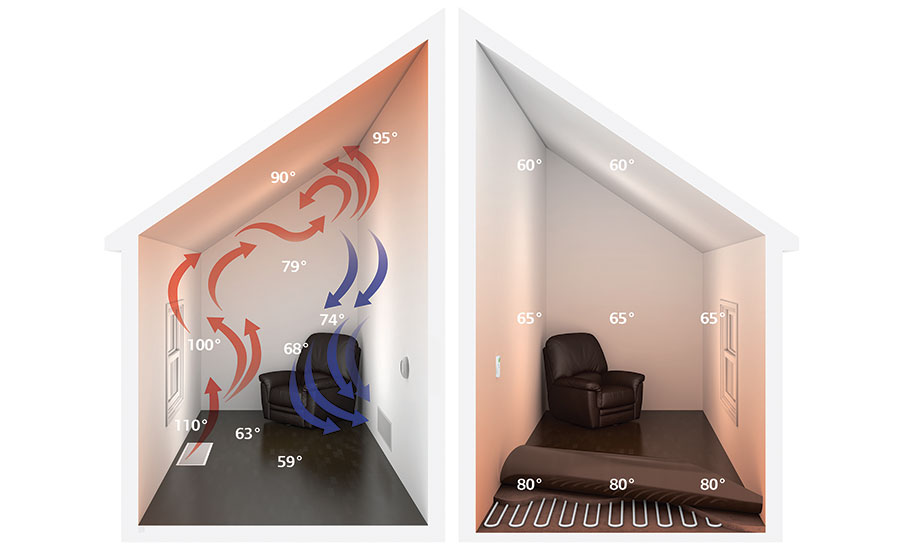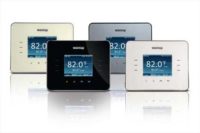Three ways radiant floor heating promotes indoor environmental quality

Indoor environmental quality (IEQ) is all about improving how we breathe, see, hear and feel inside a space. And this trend is becoming more important in residential structures, with our workforce moving from commercial buildings into homes — either partially or permanently.
This work-from-home lifestyle shift has brought a renewed focus on the clean, energy-efficient comfort of radiant floor heating. In addition to the comfort that radiant floor heating provides, there are three other important benefits that help promote a superior IEQ.
No. 1: Radiant is more comfortable than forced air
In a hydronic radiant floor heating system, warm water flows through flexible, durable PEX (crosslinked polyethylene) tubing, which can either be embedded in a concrete slab or placed on top of the subfloor or under the floor between the joists. As the warm water circulates through the tubing, the latter radiates heat up from the floor. This warms people as well as furniture to provide greater comfort.
Because radiant keeps the heat near the floor where people are located, it is in stark contrast to traditional forced-air HVAC systems, through which hot air blows into a room and quickly rises up to the ceiling.
Radiant heat is also an even heat. There are no hot or cold spots in a room, which are very common with traditional forced-air HVAC systems.
Another comfort factor with radiant is the zoning of the system. Because radiant systems are installed in zones, occupants have a separate thermostat for each radiant-heated space. This provides custom comfort control in any room. It also makes the system much more energy efficient, because rooms not in use don’t require a lot of heat.
Another reason radiant heat is so comfortable is because it most closely aligns with the ideal heating curve for the human body. In fact, people in a radiant-heated space will actually feel warmer and more comfortable at a lower thermostat setting than people in a forced-air space at a higher thermostat setting. This is because forced-air HVAC systems are the most divergent from the ideal heating curve for the human body.
No. 2: Radiant provides cleaner air
Because hydronic radiant heating systems use pumps to move water — instead of fans or blowers to push air — they do not circulate viruses, allergens, or odors throughout the indoor space. This means indoor air is much cleaner and easier to breathe.
In fact, people with severe allergies tend to have solid-surface floors with radiant, as opposed to carpet with forced-air heat. Carpets are a known breeding ground for dust mites, mold, and other microorganisms that wreak havoc on those with allergies. If a forced-air system is constantly circulating those allergens into the air, it’s easy to see why homes with solid-surface floors and radiant floor heating are vital for allergy-prone individuals.
In addition to the air-quality benefits, hydronic radiant floor heating systems also do not require ductwork. That permits greater architectural freedom, including expansive ceilings with open spaces.
No. 3: Radiant is quieter
Traditional forced-air HVAC systems and the ductwork associated with them are noisy. Most people are familiar with the loud sounds of forced-air equipment turning on and running. There is also the sound of the ductwork expanding and contracting as the hot air blows through the system and then cold air enters when the system is off.
Hydronic radiant floor heating is quiet. The water running through the tubing in the floors silently distributes warmth throughout a space. The mechanical-room parts, such as a boiler, pumps, manifolds, and actuators, also work quietly.
Best of all, radiant systems are practically maintenance-free. Beyond occasional boiler maintenance, the rest of the system does not require any annual work. Traditional HVAC systems, on the other hand, need regular replacement of air filters and equipment tune-ups, whose costs can really add up over time.
Radiant installation methods
Now that it’s clear how radiant helps to promote a superior IEQ, it’s good to know some high-level concepts for installing it. Several options are available, depending on the application.
- For embedded tubing in concrete slabs, using wire ties with rebar or stapling the tubing to foam-board insulation is a typical method.
- For structures with joists below, there are aluminum heat-transfer plates that fasten to the underside of the floor. The radiant tubing simply snaps into the plates, whose aluminum composition is an excellent heat-transfer medium to warm the floors above.
- For the tops of subfloors, there are a few good choices. One option is to staple the tubing to the wood subfloor. Another is to use radiant wood panels that feature a groove down the center for the tubing and an aluminum sheet on the underside to help transfer the heat.
There are also knobbed mats that adhere to concrete floors. These knobbed mats make it easy to simply “walk” the tubing into the mats for a quick, easy method that does not require a lot of bending down.
To learn more about the design and installation of radiant floor heating systems, look to radiant tubing manufacturer training for online or in-person instruction. In addition, check out industry resources at radiantprofessionalsalliance.org, heatinghelp.com, or healthyheating.com.
Looking for a reprint of this article?
From high-res PDFs to custom plaques, order your copy today!



